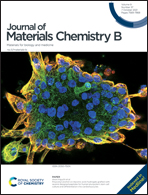A diselenide bond-containing ROS-responsive ruthenium nanoplatform delivers nerve growth factor for Alzheimer's disease management by repairing and promoting neuron regeneration†
Abstract
Alzheimer's disease (AD) is an incurable neurodegenerative disease. Repairing damaged nerves and promoting nerve regeneration are key ways to relieve AD symptoms. However, due to the lack of effective strategies to deliver nerve growth factor (NGF) to the brain, achieving neuron regeneration is a major challenge for curing AD. Herein, a ROS-responsive ruthenium nanoplatform (R@NGF–Se–Se–Ru) drug delivery system for AD management by promoting neuron regeneration and Aβ clearance was investigated. Under near-infrared (NIR) irradiation, nanoclusters have good photothermal properties, which can effectively inhibit the aggregation of Aβ and disaggregate Aβ fibrils. Interestingly, the diselenide bond in the nanoclusters is broken, and the nanoclusters are degraded into small ruthenium nanoparticles in the high reactive oxygen species (ROS) environment of the diseased area. Besides, NGF can promote neuronal regeneration and repair damaged nerves. Furthermore, R@NGF–Se–Se–Ru efficiently crosses the blood–brain barrier (BBB) owing to the covalently grafted target peptides of RVG (R). In vivo studies demonstrate that R@NGF–Se–Se–Ru nanoclusters decrease Aβ deposits, inhibit Aβ-induced cytotoxicity, and promote neurite outgrowth. The study confirms that promoting both Aβ clearance and neuron regeneration is an important therapeutic target for anti-AD drugs and provides a novel insight for AD therapy.



 Please wait while we load your content...
Please wait while we load your content...